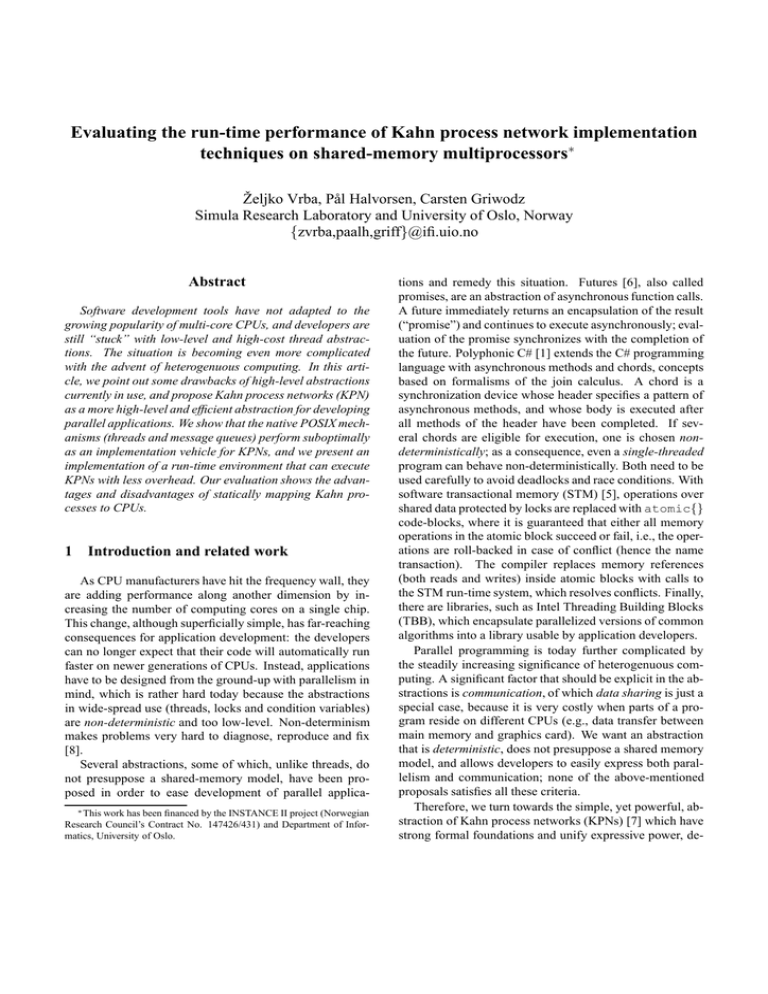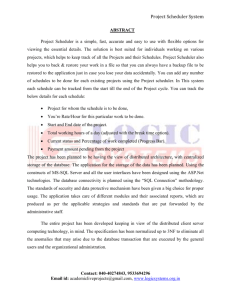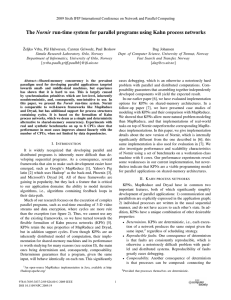Evaluating the run-time performance of Kahn process network implementation
advertisement

Evaluating the run-time performance of Kahn process network implementation
techniques on shared-memory multiprocessors∗
Željko Vrba, Pål Halvorsen, Carsten Griwodz
Simula Research Laboratory and University of Oslo, Norway
{zvrba,paalh,griff}@ifi.uio.no
Abstract
Software development tools have not adapted to the
growing popularity of multi-core CPUs, and developers are
still “stuck” with low-level and high-cost thread abstractions. The situation is becoming even more complicated
with the advent of heterogenuous computing. In this article, we point out some drawbacks of high-level abstractions
currently in use, and propose Kahn process networks (KPN)
as a more high-level and efficient abstraction for developing
parallel applications. We show that the native POSIX mechanisms (threads and message queues) perform suboptimally
as an implementation vehicle for KPNs, and we present an
implementation of a run-time environment that can execute
KPNs with less overhead. Our evaluation shows the advantages and disadvantages of statically mapping Kahn processes to CPUs.
1 Introduction and related work
As CPU manufacturers have hit the frequency wall, they
are adding performance along another dimension by increasing the number of computing cores on a single chip.
This change, although superficially simple, has far-reaching
consequences for application development: the developers
can no longer expect that their code will automatically run
faster on newer generations of CPUs. Instead, applications
have to be designed from the ground-up with parallelism in
mind, which is rather hard today because the abstractions
in wide-spread use (threads, locks and condition variables)
are non-deterministic and too low-level. Non-determinism
makes problems very hard to diagnose, reproduce and fix
[8].
Several abstractions, some of which, unlike threads, do
not presuppose a shared-memory model, have been proposed in order to ease development of parallel applica∗ This work has been financed by the INSTANCE II project (Norwegian
Research Council’s Contract No. 147426/431) and Department of Informatics, University of Oslo.
tions and remedy this situation. Futures [6], also called
promises, are an abstraction of asynchronous function calls.
A future immediately returns an encapsulation of the result
(“promise”) and continues to execute asynchronously; evaluation of the promise synchronizes with the completion of
the future. Polyphonic C# [1] extends the C# programming
language with asynchronous methods and chords, concepts
based on formalisms of the join calculus. A chord is a
synchronization device whose header specifies a pattern of
asynchronous methods, and whose body is executed after
all methods of the header have been completed. If several chords are eligible for execution, one is chosen nondeterministically; as a consequence, even a single-threaded
program can behave non-deterministically. Both need to be
used carefully to avoid deadlocks and race conditions. With
software transactional memory (STM) [5], operations over
shared data protected by locks are replaced with atomic{}
code-blocks, where it is guaranteed that either all memory
operations in the atomic block succeed or fail, i.e., the operations are roll-backed in case of conflict (hence the name
transaction). The compiler replaces memory references
(both reads and writes) inside atomic blocks with calls to
the STM run-time system, which resolves conflicts. Finally,
there are libraries, such as Intel Threading Building Blocks
(TBB), which encapsulate parallelized versions of common
algorithms into a library usable by application developers.
Parallel programming is today further complicated by
the steadily increasing significance of heterogenuous computing. A significant factor that should be explicit in the abstractions is communication, of which data sharing is just a
special case, because it is very costly when parts of a program reside on different CPUs (e.g., data transfer between
main memory and graphics card). We want an abstraction
that is deterministic, does not presuppose a shared memory
model, and allows developers to easily express both parallelism and communication; none of the above-mentioned
proposals satisfies all these criteria.
Therefore, we turn towards the simple, yet powerful, abstraction of Kahn process networks (KPNs) [7] which have
strong formal foundations and unify expressive power, de-
terministic behavior, and asynchronous communication and
execution. Furthermore, their graph representation makes
it easy to reason about communication patterns and to employ advanced scheduling and load-balancing algorithms.
All of these properties should contribute to easier application development, debugging and, possibly, better run-time
performance because schedulers have more information.
Since processes in a KPN execute asynchronously, parallelism with fine granularity (more processes) may lead
to more parallelism at run-time, provided there are enough
CPUs. Furthermore, fine granularity is desirable because
otherwise the deterministic nature of KPNs may result in
much blocking. However, fine granularity also presupposes
an efficient run-time environment that can support many
processes with low overhead, even on few CPUs.
In this paper, we focus on the performance that this
paradigm can achieve on shared-memory multiprocessors,
since these systems have the highest importance on today’s
computing market. We show that the native POSIX mechanisms (threads and message queues), when used in the
obvious way, are not well suited for implementing a runtime environment for executing KPNs. We have therefore implemented an optimized KPN run-time environment
which is shown by benchmarks to have significant performance improvements (∼ 2 times faster message passing,
up to ∼ 6.5 times faster scheduling) compared to the native
mechanisms.
2 Kahn process networks
A KPN [7] consists of processes and channels, and it
has a simple representation as a directed graph (see figure
2 for examples). A process encapsulates data and a single,
sequential control flow, independent of any other process.
Processes are not allowed to share data and may communicate only by sending messages over channels. Channels are
infinite FIFO queues that store discrete messages. Channels
have exactly one sender and one receiver process on each
end (1:1), and every process can have multiple input and
output channels. Sending a message to the channel always
succeeds, but trying to receive a message from an empty
channel blocks the process until a message becomes available. It is not allowed to poll a channel for presence of data.
These properties fully define the operational semantics of
KPNs and make the Kahn model deterministic, i.e., the history of messages produced on the channels does not depend
on the order in which the processes are executed, provided
the scheduling is fair.
The theoretical model of KPN described so far is idealized in two ways: 1) it places few constraints on process
behavior, and 2) it assumes that channels have infinite capacities. The first assumption makes it possible to construct
a KPN that under no circumstances can be executed in finite
space. We shall therefore consider only effective networks,
i.e., networks where each sent message is eventually read
from the channel.
The second assumption presents an obvious difficulty because any actual KPN implementation runs in finite memory. A common (partial) solution is to assign capacities to
channels and redefine the semantics of send to block the
sending process if the delivery would cause the channel to
exceed its capacity. Under such send semantics, an artificial deadlock may occur, i.e., a situation where a cyclically
dependent subset of processes is blocked, but which would
continue running in the theoretical model. The algorithm of
Geilen and Basten [4] resolves the deadlock by traversing
the cycle to find the channel of least capacity and enlarging
it by one message, thus resolving the deadlock.
3 KPN implementation
To the best of our knowledge, there exist only two other
general-purpose KPN runtime implementations: YAPI [3]
and Ptolemy II [2]. YAPI is not a pure KPN implementation, as it extends the semantics and thus introduces the
possibility of non-determinism, its code-base is too large for
easy experimentation (120 kB vs. 23 kB in our implementation), and we were unable to make it use multiple CPUs.
Ptolemy II is implemented in Java, which makes it difficult
to experiment with low-level mechanisms such as contextswitching and scheduling.
The easiest way to implement a KPN run-time is to use
existing OS facilities (see table 1), but, as shown in this paper, such approach suffers from high overheads. We have
therefore implemented a KPN execution environment in
C++, with small portions specific to the Solaris OS and the
AMD64 architecture.1
When the KPN is started, m runner threads are created
and scheduled by the OS onto n available CPUs (see figure
1). A runner thread (“runner”) schedules KPs from a private run-queue by a fair algorithm;2 KPs are assigned and
pinned to runners at KPN creation time. The scheduling on
each CPU is cooperative with yield points being message
send/receive operations. Context switching is implemented
in assembly. When there are no runnable KPs, the runner
sleeps on a private counting semaphore until woken up by a
KP belonging to another runner.
Channels are implemented in two layers: an upper layer
which handles interaction with KPs and the scheduler, and a
lower layer where the actual transport mechanism is implemented. When a KP wants to block, it cannot use standard
OS mechanisms because doing so would block the whole
1 The code is available at http://simula.no/research/
networks/software
2 The current prototype uses the round-robin policy for its simplicity,
but this is easily changed.
Code
P/U
1/2/n
O/N
Parameter
Pthread scheduler (P) is the native scheduler with
dynamic load-balancing over available CPUs
and 1 thread / KP. Our scheduler (U), so far, only
supports static assignment of KPs to CPUs.
Number of runner threads for our scheduler; n
for the pthread scheduler.
Our optimized transport; zero-copy (see section
3) / Native transport (POSIX message queues;
copies message contents).
Table 1. Benchmark parameters.
Figure 1. Two-level KPN scheduling
runner thread and prevent dispatching of another KP. Instead, our scheduler provides a sleep/wake-up synchronization object that is optimized for 1:1 communication.
Since KPs are executing in a shared address space, it is
still possible that they modify each other’s state and thus
ruin the Kahn semantics. To minimize the possibility of
this happening, the message class contains only a pointer to
message contents in shared memory and implements move
semantics: send operation nullifies the pointer, making message contents inaccessible to the sender. This allows for a
zero-copy message transport where a channel is a linked list
of messages, and links are embedded in the message body.
The trade-off is that message creation, destruction and assignment require dynamic memory (de)allocation which we
optimize by using Solaris’s libumem allocator.
We have not implemented any special support for I/O
operations yet because our current research interests lie in
adaptive scheduling and load-balancing of KPNs. Using the
usual blocking UNIX I/O calls in KPs can block the runner
which will then be unable to dispatch another KP. One possible solution to this problem is to have separate runners for
KPs doing I/O; another is to use asynchronous I/O API. We
use the first approach, since it is the simplest.
4 Benchmarks
We have implemented several benchmarks (see figure
2) to compare the efficiency of scheduling and message
transport mechanisms shown in table 1. The bottleneck in
the “ring” benchmark is message-passing and scheduling,
while the bottleneck in the advanced encryption standard
(AES) benchmark is CPU bandwidth. The third benchmark
simulates an execution of an H.264 encoder based on data
obtained by profiling a real encoder.3
The benchmarks are compiled with Sun’s C++ compiler
with maximum optimizations in 64-bit mode and executed
3 x264;
available
at
developers/x264.html
http://www.videolan.org/
on an otherwise idle 2.2 GHz dual-core AMD Athlon with
2 GB of RAM running Solaris 10. Each data point is
an average of 10 consecutive runs and reports the elapsed
real (wall-clock) time4 measured by a high-resolution timer
(gethrtime function). To reflect the true cost of communication, measurements also include the overhead of dynamic memory (de)allocations (see section 3). The graphs
have min/max error bars, but the variability of the measurements was so small that they are barely visible.
4.1
Ring: context-switch and messagepassing performance
Since KPNs rely heavily on message passing, we measure the duration of the composite transaction [send →
context switch → receive]. We employ the same method
as the lat ctx benchmark from the lmbench suite.5 KPs
P0 . . . Pn−1 , are created and connected into a ring topology
(see figure 2(a)). P0 sends an initial message with payload
of 4 bytes (so that copying overhead for native transport is
negligible) and measures the time it takes to make m roundtrips.
The number of KPs n is varied from 10 to 1000 in
steps of 50. The number of round-trips m is adjusted so
that the total number of transactions is approximately 106 ,
i.e., m = b106 /nc, which gives a sufficiently long execution time and number of transactions to cancel out the
the noise of scheduling effects such as interrupt processing. This benchmark is also sensitive to KP placement:
with good placement (G), inter-CPU synchronization every bn/kc transactions, k being the number of CPUs. With
bad placement (B), synchronization on every transaction.
Benchmark results for three different configurations (cf. table 1) are shown in figure 3.
4 The wall-clock time metric is most representative because it accurately
reflects the real time needed for task completion, which is what the endusers are most interested in. We have also measured system and user times
(getrusage), but do not use it to present our results because 1) it does
not reflect the reduced running time with multiple CPUs, and 2) resource
usage does not take into account sleep time.
5 http://www.bitmover.com/lmbench/
Fn
2
ME
Fn−1
1
+/−
T
Q
+
Ti
Qi
R
EC
MC
P
1
n−1
S
CIP
IP
n
0
(a) Ring
(b) AES
(c) H.264. Fn and Fn−1 are current and previous frames.
Other components are listed in table 2.
Figure 2. KPNs for the “ring”, “AES” and H.264 benchmarks.
20
15
10
5
bad placement (x=B)
good placement (x=G)
0
0
100
200
300
400
500
600
700
Number of processes (n)
(a) P/x/n/N
800
20
bad placement (x=B)
good placement (x=G)
Per-transaction time (microseconds)
Per-transaction time (microseconds)
Per-transaction time (microseconds)
20
15
10
5
0
900
1000
1 runner (x=NA,y=1)
2 runners/bad (x=B,y=2)
2 runners/good (x=G,y=2)
15
10
5
0
0
100
200
300
400
500
600
700
Number of processes (n)
800
900
1000
0
100
200
(b) P/x/n/O
300
400
500
600
700
Number of processes (n)
800
900
1000
(c) U/x/y/O
Figure 3. Performance of the “ring” test in different configurations. x and y are parameter placeholders whose values are given in figure legends (see also table 1 for explanation of parameters).
We can draw several conclusions from these tests. First,
inter-CPU synchronization is expensive, which is confirmed
by observing the difference in running times of the benchmark with good and bad KP placement. We believe that it
is also the cause for the anomaly of the U/G/2/O configuration in figure 3(c), where it can be seen that the running
time increases as the number of KPs decreases below 100.
Second, the test shows that our optimized transport is
∼ 1.7–1.9 times faster than the native transport. The exact speedup is dependent on the workload, KP placement
and message size. The native transport has constant performance for messages up to 128 bytes, after which it degrades
proportionally with the message size, due to its copying semantics (not shown in the graphs).
Third, our user scheduler performs best with a single
runner because lock contention never happens. In the
U/B/2/O configuration, it performs slightly worse than the
pthread scheduler for less than ∼ 100 KPs. As the number of KPs grows, it starts to outperform the pthread scheduler, whose performance becomes worse while ours remains
constant, and it is 1.25 times faster for n = 1000 KPs. With
good KP placement (U/G/2/O configuration) and n = 1000,
our scheduler is 6.5 times faster than the pthread scheduler
(P/G/n/O configuration), and achieves nearly the same per-
formance as with single runner.
4.2
AES: scheduling overheads
Application overdecomposition (having more workers
than CPUs) is important because communication latencies
and blocking times may overlap with computation, and because performance will transparently improve as more processors are added. One of the goals of our run-time is to
enable overdecomposition without incurring large performance penalty on compute-intensive tasks, such as 128-bit
AES encryption.
The source KP S hands out equally-sized memory
chunks to n worker KPs which reply back when they have
encrypted the given chunk (see figure 2(b)). The exchanged
messages are carrying only pointer-length pairs (16 bytes in
total). We fix the total block size to 228 bytes (256 MB, to
avoid possible swapping), fix the number of passes through
each to 8 (to achieve sufficiently long running time), and
vary the base-2 logarithm of memory chunk size, k, from 14
to 28. A worker KP is created for every chunk of memory,
so there are n = 228−k KP workers in total. In the U/2/O
configuration, KPs are assigned to CPUs in a round-robin
manner to evenly distribute the load among CPUs.
250
Stage
Choose inter-/intra-prediction (CIP)
Intra-analysis (IP)
Inter-analysis (MC+ME)
Prediction (P)
Macroblock encoding (T,Ti,Q,Qi)
Entropy encoding (EC)
Other, including reordering (R)
P/n/O
U/2/O
Encryption speed (MB/s)
200
150
100
Time %
8.08
5.02
34.36
23.83
8.69
6.72
13.3
Table 2. Cachegrind profiling data of x264.
50
0
14
15
16
17
18
19
20 21 22 23
Chunk size (log2)
24
25
26
27
28
50
Figure 4. Performance of AES encryption.
4.3
H.264 encoder
Our KPN representation of an H.264 video encoder (see
figure 2(c)) is only a slight adaptation of the encoder block
diagram found in [9]. Each functional unit is implemented
as a KP, with additional KPs inserted at the branch points
of the original diagram. Since the P, MC and ME stages
are together using over 50% of the CPU, each of these has
been parallelized (not shown in the figure) in the same way
as AES.
40
Encoding speed (fps)
Figure 4 shows the encryption throughput versus the
number of workers; note that the number of workers increases to the left, as the chunk size decreases. The 50%
drop in speed at n = 28 occurs because the task is serially
executed on a single CPU.
As the number of KPs increases beyond 2048 (chunk
size less than 217 ), the encryption speed decreases, but
much more sharply for the pthread scheduler. By running
vmstat in parallel, we have confirmed that this was not
caused by swapping. Furthermore, when using the pthread
scheduler with 16384 worker KPs, there are approximately
25000 context-switches, 35000 system calls and 30000 instruction TLB misses per second. In contrast, our scheduler
with 16384 worker KPs has < 500 system calls and context
switches per second (which almost coincides with the numbers on an idle system), and < 2000 instruction TLB misses
per second (< 1000 on an idle system).
While we have not been able to find the exact causes of
this behavior, we believe, based on real-time monitoring by
advanced tools such as dtrace and truss, that they stem from
the combination of the (preemptive) pthread scheduler and
lock contention. Whatever the root cause, it is obvious that
the pthread scheduler has some trouble as the number of
threads increases beyond 2048. These results indicate that
our scheduler is better suited for executing overdecomposed
problems than the native OS scheduler.
P/n/N
P/n/O
U/G/2/O
U/G/1/O
30
20
10
0
1
100
500
1000
Number of workers in each of P, MC, ME stages
Figure 5. Performance of the H264 encoder.
For simplicity, encoding operations are replaced with
loops that consume a percentage of CPU time corresponding to that used by the x264 codec at respective stages. The
amount of time spent in each x264 function has been profiled with the cachegrind tool, and mapping of these results
to the block diagram is shown in table 2. The loops have
been adjusted so that the “frames” are “encoded” at approximately 25 fps in real-time. We measure the time needed
to “encode” 300 frames (12 seconds) in different configurations. For each configuration, the benchmark is executed
with 1, 100, 500 and 1000 workers in each of the P, MC and
ME stages (up to 3000 additional workers in total).
We draw the following conclusions from the results in
figure 5: 1) data dependencies in KPN prohibit linear scalability with the number of cores; 2) message transport (P/N
vs. P/O) has no influence on running time because the
workload is CPU-bound and few messages are exchanged;
3) with few KPs and little available parallelism, the native
scheduler’s dynamic load-balancing outperforms our static
assignment of processes; and 4) when the application is
overdecomposed and KPs are carefully placed, our scheduler performs as well as, or better than the native.
5 Conclusion and future work
In this paper, we have motivated the use of the KPN formalism as an alternative to other abstractions intended to
simplify development of parallel applications. Compared
to futures, transactional memory and joins, the KPN framework unifies determinism and explicit modeling of communication. It does not rely on shared memory, so it is also
suitable for designing distributed systems. We have described our implementation, whose cornerstones are an optimized zero-copy message transport and a two-level scheduler. Benchmarking on the Solaris 10 OS shows that our implementation makes significant scalability and performance
improvements over native mechanisms (POSIX message
queues and kernel thread scheduler): in our tests, message
transport is 1.7–1.9 times faster, and the scheduler is up to
6.5 times faster.
The “AES” and “H.264” benchmarks show that our
scheduler scales much better than the pthread scheduler in
situations with a large number of CPU-intensive processes
(see figures 4 and 5). This is best illustrated on the H.264
benchmark with 1 and 1000 workers in each of the P, MC
and ME stages: our scheduler suffers a performance drop of
∼ 10%, while the performance of the pthread scheduler is
nearly halved. Experiment 3 shows also that static assignment of KPs to CPUs can lead to blocking that cancels out
the benefits of more efficient scheduler.
We are currently working on extending our scheduler
with dynamic load-balancing strategies that take CPU requirements of processes as well as their communication patterns into account. Scheduling according to communication
intensity is significant because some of today’s multi-core
systems have non-uniform memory architecture, where it
is desirable to place heavily communicating processes on
nearby CPUs. Such scheduling would be even harder to design and implement for abstractions that are less structured
than KPNs (e.g., transactional memory).
References
[1] N. Benton, L. Cardelli, and C. Fournet. Modern concurrency abstractions for c#. ACM Trans. Program. Lang. Syst.,
26(5):769–804, 2004.
[2] C. Brooks, E. A. Lee, X. Liu, S. Neuendorffer, Y. Zhao, and
H. Zheng. Heterogeneous concurrent modeling and design
in java (volume 1: Introduction to Ptolemy II). Technical
Report UCB/EECS-2008-28, EECS Department, University
of California, Berkeley, Apr 2008.
[3] E. de Kock, G. Essink, W. J. M. Smits, R. van der Wolf, J.-Y.
Brunei, W. Kruijtzer, P. Lieverse, and K. K.A. Vissers. Yapi:
application modeling for signal processing systems. Proceedings of Design Automation Conference, pages 402–405, 2000.
[4] M. Geilen and T. Basten. Requirements on the execution of
kahn process networks. In Programming Languages and Sys-
[5]
[6]
[7]
[8]
[9]
tems, European Symposium on Programming (ESOP), pages
319–334. Springer Berlin/Heidelberg, 2003.
T. Harris, S. Marlow, S. Peyton-Jones, and M. Herlihy. Composable memory transactions. In PPoPP: Proceedings of the
ACM SIGPLAN symposium on Principles and practice of parallel programming, pages 48–60, New York, NY, USA, 2005.
ACM.
J. Henry G. Baker and C. Hewitt. The incremental garbage
collection of processes. Technical report, Cambridge, MA,
USA, 1977.
G. Kahn. The semantics of a simple language for parallel
programming. Information Processing, 74, 1974.
E. A. Lee. The problem with threads. Computer, 39(5):33–42,
2006.
I. E. G. Richardson. H.264/mpeg-4 part 10 white paper.
Available online. http://www.vcodex.com/files/
h264_overview_orig.pdf.







